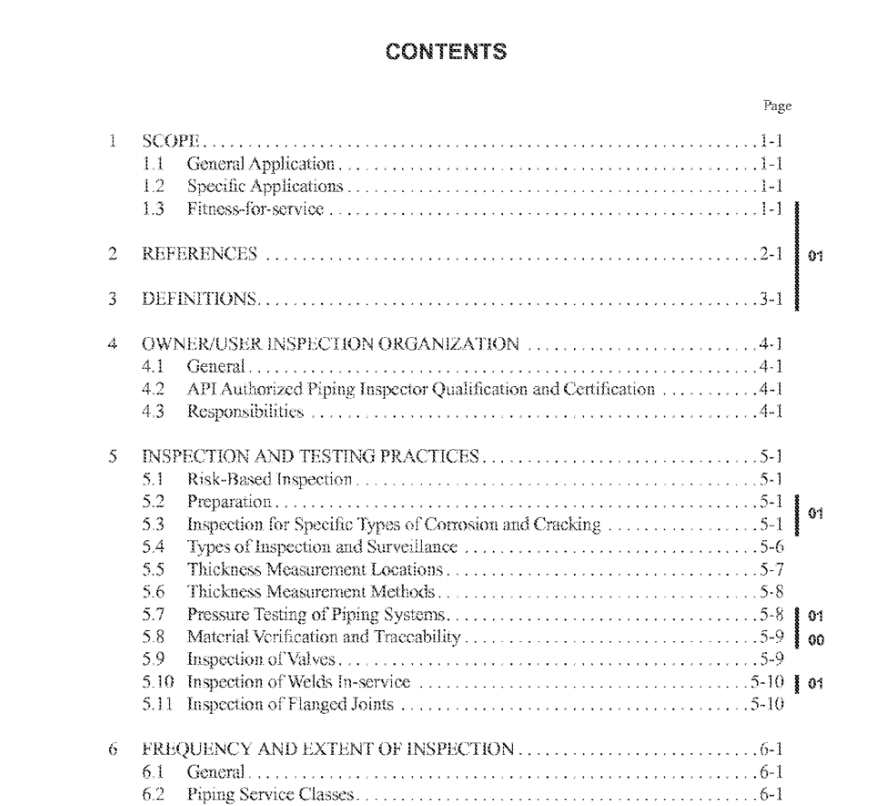API 570 pdf download

API 570 pdf download,Piping Inspection Code-Inspection, Repair, Alteration, and Rerating of In-service Piping Systems
For the purposes of this standard, the following definitions apply. 3.1 alteration: A physical change in any component that has design implications affecting the pressure containing capability or flexibility of a piping system beyond the scope of its design. The following are not considered alterations: comparable or duplicate replacement; the acdition of any reinforced branch connection equal to or less than the size of existing reinforced branch connections; and the addition of branch connections not requiring reinforcement. 3.2 applicable code: The code, code section, or other ree- ognized and generally accepted engineering standard or prac- tice to which the piping system was buit or which is deemed by the owner or user or the piping engineer to be most appro- priate for the situation, including but not limited to the latest edition ofASME B31.3. 3.3 ASME B31.3: A shortened form of ASME B313, Pr)- cess Piping, published by the American Society of Mechani- cal Engineers. ASME B31.3 is witten for design and construction of piping systems. However, most of the techni- cal requirements on design, welding, examination, and materi- als also can be applied in the inspection, rerating, repair, and alteraton of operating piping systems. When ASME B313 cannot be followed because of its new construction coverage (such as revised or new material specifications, inspection requirements, certain heat treatments, and pressure tests), the piping engineer or inspector shali be guided by API 570 in lieu of strict conformity to ASME B31.3. As an exarmple of intent, the phrase“principles of ASME B31.3″ has been employed in API 570, rather than“in accordance with ASME B31.3” 3.4 authorized inspection agency: Defined as any of the following: a. The inspection organization of the jurisdiction in which the piping system is used. b. The inspection organization of an insurance company that is licensed or registered to write insurance for piping systems. C. An owner or user of piping systems who maintains an inspection organization for activities relating only to his equip- ment and not for piping systems inrended for sale or resaie. d. An independent inspection organization employed by or under contract t0 the owner or user of piping systems that are used only by the owner or user and not for sale or resale. e. An independent inspection organization licensed or recog- nized by the jurisdiction in which the piping system is used and employed by or under contract t0 the owner or user. 3.5 authorized piping inspector: An employee of an authorized inspection ngency who is qualified and certified to perform the functions specified in API 570. A nondestructive (NDE) exaniner is not required 10 be an authorized piping inspector, Whenever the term inspector is used in API 570, it refers to an authorized piping inspector. 3.6 auxiliary piping: Instrument and machinery piping. typically small-bore secondary process piping that can be iso- lated from primary piping systems. Examples include fush lines, seal oil lires, analyzer lines, balance lines, buffer gas lines, drains, and vents. 3.7 critical check valves: Vaives that have been identifed as vital to ptrocess safety and 1must operate reliably in order 10 avoid the potential for hazardous events or substantial conse- quences should a leak oCcur. 3.8 CUl: Corrosion under insulation, including stress corro- sion cracking under insulation. 3.9 deadiegs: Components of a piping system that nor- mally have no significant fow. Examples include the follow- ing: blanked branches, lines with nomally closed block valves, lines witb one end bianked, pressurized dummy sup- port legs, stagnant control valve bypass piping, spare pump piping, level bridles, relief valve inlet and outlet beader pip- ing, pump trim bypass lines, high-point vents, sample points, drains, bleeders, and instrument connections. 3.10 dlefect: An imperfection of a type or magniude exceeding tbe acceptable criteria.









